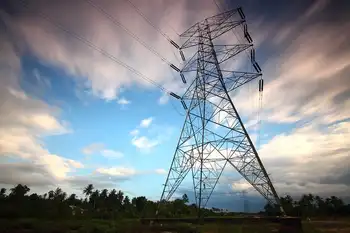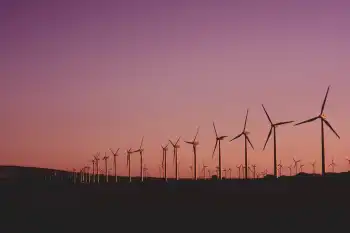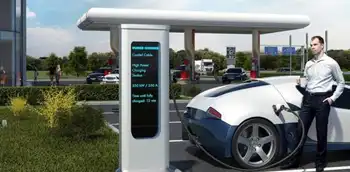Large turnout for wind farm public meeting
By NorthumberlandToday
NFPA 70e Training
Our customized live online or in‑person group training can be delivered to your staff at your location.

- Live Online
- 6 hours Instructor-led
- Group Training Available
It was far beyond standing-room-only for those squeezed around the edges of the seated audience packed into the Centreton Community Centre. Some were unable to get into the building, forced to stand on the steps and sidewalks outside. Inside, two petitions against wind farms and a third, a list for people to sign if they wanted information, were laid out on tables at the back of the hall together with blowup pictures detailing the size of wind turbines that would dot the Oak Ridges Moraine if Energy Farm Ontario Inc. goes forward with its industrial wind installation.
Organized by RR2 Grafton resident Gwyer Moore and a working group of about 10 people who oppose the plan (they're in the process of obtaining charity status for the Alliance for the Protection of the Northumberland Hills), the rural community meeting featured two very passionate speakers warning about the negative health effects of wind turbines. The meeting was billed as an "information forum on the potential impact of industrial wind turbines" but focused solely on the adverse effects.
Ironically, the meeting coincided with Premier Dalton McGuinty's announcement earlier in the day about increased minimum distances between wind turbines and residences (550 metres) but the first speaker, Carmen Krogh, said this was not enough.
"They're going to be too close," said the woman who suffers a series of symptoms she says are caused by proximity to wind turbines.
These include severe migraines, ringing in the ears, inability to sleep and other significant side effects.
An organization called VOW (Victims of Wind) is a support group for people who are living near wind farms and are sick, she said. There are two sources of problems, she said: infrasound (low-frequency sound that can't be heard by people) and the decibel levels that can be heard.
The first is the worst, Krogh suggested, and is the cause of such effects as sleep disorders, migraines, vertigo, mental health changes and a strobe-like effect that results in "bouncing eyeballs." Fatigue, difficulty breathing and tremendous ear pain, are other effects but not everyone reacts the same way or within the same time after exposure, she said. Some people suffer from heart palpitations that "make you think you're going to have a heart attack."
Many families living near wind turbine farms have been forced to move, some abandoning their rural properties, said Krogh, a former Health Canada employee and editor of the CPS (Compendium of Pharmaceuticals and Specialties), a book published annually by the Canadian Pharmacists Association. She warned that proper studies, peer reviewed, must be undertaken before wind turbines "are introduced into our environment."
Once there, wind turbines are not easily removed, she cautioned.
She also talked about Wind Concerns Ontario (WCO), of which the new Alliance for the Protection of Northumberland Hills is listed as a member. WCO is made up of organizations with similar concerns about the impact of wind farms. A story posted September 24 on its website (www.windconcernsontario.wordpress.com) describes the newest provincial government setback regulations of 550 metres for homes next to wind turbines as a "betrayal of the people of rural Ontario."
Everyone, even healthy people, are "at risk" of the impacts from wind turbine farms, Krogh said. The opposition is growing worldwide yet people complaining of illness are ridiculed and discounted, she added.
Currently there are about 600 wind turbines in Ontario, Krogh told the crowd.
David Colling, a dairy farmer and electrical pollution consultant from Ripley who has been doing voltage testings near wind turbines, provided charts and anecdotal information about what he has found.
Colling warned farmers that signing up with wind farm developers to lease their land for wind turbines can lead to many problems. Originally, he did that because he supported green energy, but the outcome in many cases is electrical pollution that is making people ill, he said.
Instead of producing "clean" electricity, the wind turbine process can create "dirty" electricity with electromagnetic waves and harmonic distortions, he said. This can occur where the wind energy is converted into electrical energy and around substations where it is connected to the electrical grid, he said.
It affects people differently, but Colling listed the same types of symptoms as Krogh had, agreeing that it is so severe in some cases it is actually driving people who live near wind farms out of their homes.
Today, there are all types of sources of dirty electricity, including computers, variable- speed motors (like those used on wind turbines), television sets, and compact fluorescent light bulbs like the kinds used in homes today, Colling said.
While neither Krogh nor Colling talked about this, Queen's University is in the midst of a study looking at the health of residents near the recent Wolfe Island, Ontario wind farm installation. It is comparing survey results before and during construction and after the wind turbines have been up and running.
"To our knowledge, this is the first time that people have acquired a snapshot of community health prior to wind turbines," lead research scientists Neal Michelutti said in a published interview. "It gives us (a sense of) community health that we can use in a before-and-after comparison."
Across Ontario there are people on both sides of the wind turbine green energy questions. The government is providing incentives to create jobs in the industry and recently McGuinty described complainers as having a "not in my back yard mentality."
He said the new guidelines strike a balance between opponents and wind farm developers.
The wind farm proposal for the Grafton area is still in its study-phase, Energy Farm Ontario Inc. officials say. They said they were not invited to the public meeting in Centreton but at the same time were busy at the wind turbine conference held in Toronto.
Energy Farm Ontario Inc. hosted a public session locally in July on its study to develop the Grafton wind turbine farm.











